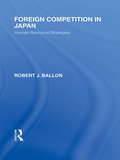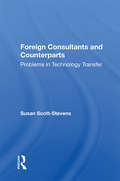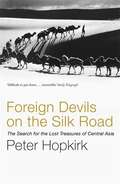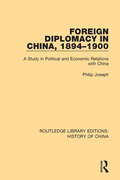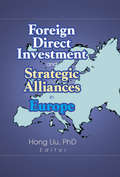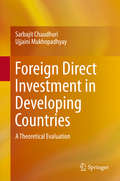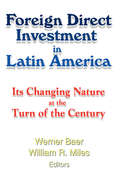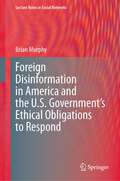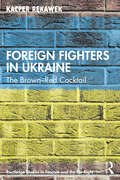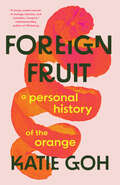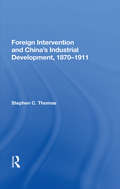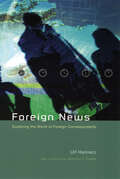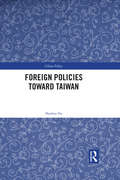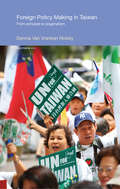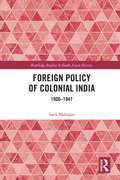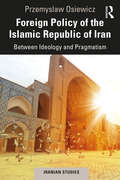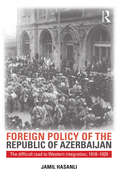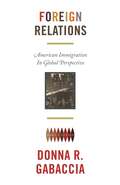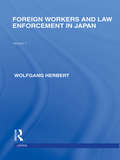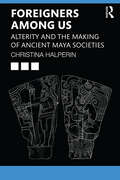- Table View
- List View
Foreign Competition in Japan: Human Resource Strategies (Routledge Library Editions: Japan)
by Robert J BallonThe Japanese market is an attractive and challenging one. It is essential for foreign companies wanting to establish a growing presence to build operations which are suited to the Japanese. This book focuses on three particular areas: the labour market, the workplace and the market-place. The management of human resources plays an important part in a company’s image in the market. A strong corporate presence is vital to inspire confidence among consumers and the career opportunities and job stability offered by a company reflect its strength. Using case studies and covering topics such as the labour market, corporate organization, decision making and business transactions, this book outlines the way the Japanese organize their companies; it analyzes the approach of foreign firms and stresses the strategies they should adopt to enhance their competitive image. The comprehensive analysis of the Japanese work environment together with its focus on foreign competition will make the book essential reading for all those interested in international business, human resources, marketing and Japanese studies.
Foreign Consultants And Counterparts: Problems In Technology Transfer
by Susan Scott-StevensEven though concern about and interest in technology transfer have existed since the 1950s, it has become of increasing importance to lesser-developed and developing countries since the 1970s. The transfer of technology in general, and in particular the transfer of technical knowledge, lies at the heart of the North-South debate. There is an abundance of literature on technology transfer in almost every field of interest--policy, practice, applied case studies, and general recommendations--but little, if any, of the information is integrated. It remains widely distributed throughout the fields of economics, business, rural sociology, and anthropology. The same may be said for various studies of consultants as change agents. On the other hand, studies of counterparts--host country professionals--have been almost entirely neglected, with the exception of their implied roles as innovators or acceptors. There have been few attempts to tie practice to theory, theory to research, or research to practice. This volume attempts to provide the link between theory, research, and practice. Based upon research conducted at two large-scale water resource development projects in Indonesia, it focuses upon the problems and solutions encountered by two primary sets of people involved in the transfer of technical knowledge--foreign consultants and host country counterparts. Dr. Scott-Stevens presents a unified and applied approach to many of the cross-cultural theories, issues, and problems common to the transfer of technical knowledge across cultures.
Foreign Devils on the Silk Road: The Search for the Lost Treasures of Central Asia
by Peter HopkirkThe story of the intrepid men who, at great personal risk, led the long-range archaeological raids on the Silk Road, incurring the undying wrath of the Chinese The Silk Road, which linked imperial Rome and distant China, was once the greatest thoroughfare on earth. Along it traveled precious cargoes of silk, gold, and ivory, as well as revolutionary new ideas. Its oasis towns blossomed into thriving centers of Buddhist art and learning. In time it began to decline. The traffic slowed, the merchants left, and finally its towns vanished beneath the desert sands to be forgotten for a thousand years. But legends grew of lost cities filled with treasures and guarded by demons. In the early years of the last century foreign explorers began to investigate these legends, and very soon an international race began for the art treasures of the Silk Road. Huge wall paintings, sculptures, and priceless manuscripts were carried away by the ton and are today scattered through the museums of a dozen countries.
Foreign Diplomacy in China, 1894-1900: A Study in Political and Economic Relations with China (Routledge Library Editions: History of China #6)
by Philip JosephThis book, first published in 1928, examines the first diplomatic contacts between China and the West. China had not always been isolated from the Western world, as travellers had visited China in the Middle Ages, but it was not until the end of the eighteenth century that efforts were first made to establish regular relations with China. This book traces the development of diplomatic relations from the Treaty of Nanking in 1842 to the start of the twentieth century.
Foreign Direct Investment and Strategic Alliances in Europe
by Hong LiuAdvance your business interests in the ever-changing European market!Foreign direct investment (FDI) and strategic alliances are among the most popular modes of international market entry and expansion in major markets by multinationals. This informative book uses case examples, a wide-ranging survey, and the expertise of authorities in the field to shed light on the when, why, and how of investing and forming alliances in the volatile environment of the European market.Providing both theoretical background and fascinating case studies, Foreign Direct Investment and Strategic Alliances in Europe begins with an examination of the relationship between contextual and strategic factors and foreign market entry strategies. Then it illustrates its meaning with a real-world application of that information, in this case examining the way Israeli manufacturers developed their entry strategies in the European Union.This insightful book also: analyzes the market entry, development, and expansion of the Coca-Cola company in Russia discusses strategic problems, barriers to expansion, and first- versus late-mover advantages in Russia&’s transition economy looks at the relationship between United States software firms and European companies provides guidelines for choosing what form a strategic alliance should take presents a survey of 114 international strategic alliances between firms in the United Kingdom and their European, American, and Japanese partnersStrategic alliances and foreign direct investment are expected to continue to flourish in Europe. By integrating FDI issues with those of strategic alliances, this well-referenced book will provide you with insights into both areas as well as up-close perspectives on specific segments of the European market.
Foreign Direct Investment in Developing Countries
by Ujjaini Mukhopadhyay Sarbajit ChaudhuriIn development literature Foreign Direct Investment (FDI) is traditionally considered to be instrumental for the economic growth of all countries, particularly the developing ones. It acts as a panacea for breaking out of the vicious circle of low savings/low income and facilitates the import of capital goods and advanced technical knowhow. This book delves into the complex interaction of FDI with diverse factors. While FDI affects the efficiency of domestic producers through technological diffusion and spill-over effects, it also impinges on the labor market, affecting unemployment levels, human capital formation, wages (and wage inequality) and poverty; furthermore, it has important implications for socio-economic issues such as child labor, agricultural disputes over Special Economic Zones (SEZ) and environmental pollution. The empirical evidence with regard to most of the effects of FDI is highly mixed and reflects the fact that there are a number of mechanisms involved that interact with each other to produce opposing results. The book highlights the theoretical underpinnings behind the inherent contradictions and shows that the final outcome depends on a number of country-specific factors such as the nature of non-traded goods, factor endowments, technological and institutional factors. Thus, though not exhaustive, the book integrates FDI within most of the existing economic systems in order to define its much-debated role in developing economies. A theoretical analysis of the different facets of FDI as proposed in the book is thus indispensable, especially for the formulation of appropriate policies for foreign capital.
Foreign Direct Investment in Latin America: Its Changing Nature at the Turn of the Century
by Werner Baer William MilesExamine the changing nature of foreign investments in Latin America!Generously enhanced with easy-to-understand charts, tables, and graphs, this book covers the ins and outs of foreign direct investment in the established and emerging markets of Latin America. In addition to an overview of direct investment for the entire Latin American region in the 1990s, this valuable book examines specific countries&’ experiences with FDI in that decade. These include Argentina, Chile, Mexico, Brazil, Peru, Ecuador, Paraguay, Costa Rica, El Salvador, Guatemala, Honduras, and Nicaragua.Spending on environmental projects is on the rise, and Latin American nations are at the forefront of this financial whirlwind in the developing world. Foreign Direct Investment in Latin America: Its Changing Nature at the Turn of the Century examines the difficulties of assessing environmental investments. It analyzes the role of international capital in Latin-American environmental issues and discusses the major players, such as the World Bank, in international capital and the environment.Foreign Direct Investment in Latin America presents case studies that illustrate: the history of FDI in Argentina and the impact of the privatization of state-owned enterprises in 1991-1993 the similarities and differences between 1990s FDI in Mexico and Chile the ways that modern investment in Brazil differs in purpose from investment there in previous economic eras how Peru addressed its balance-of-payments crisis in a time when its domestic financial markets were thin and there existed few sources of financing besides banks how Paraguay&’s historical lack of infrastructure has hampered FDI efforts there Ecuador&’s financial and balance-of-payments crisis-its currency is in free-fall and its financial institutions are on the brink of collapse . . . and much more!Foreign Direct Investment in Latin America packs all this valuable information into a single user-friendly source. As we move into the new millennium, no student, educator, or investor interested in this quickly evolving, volatile market should be without it!
Foreign Direct Investment in Post-Crisis Korea: European Investors and 'Mismatched Globalization' (Routledge Advances in Korean Studies)
by Judith CherryIn this book Judith Cherry analyses the impact of economic and cultural globalization on efforts to promote inward foreign direct investment (IFDI) in South Korea over the past four decades. The book traces the development of Korean IFDI policy from one of restriction and control to one of encouragement and promotion. Specifically, it focuses on the challenges inherent in reforming the ‘software’ of IFDI promotion (socio-cultural issues, mindsets and perceptions) as opposed to changing its ‘hardware’ (systems, laws and regulations). Although the Korean government has made sustained efforts over the past decade to enhance Korea’s attractions as a host for inward investment, it has faced significant challenges in improving Korea’s IFDI performance. The discussion in this book of the wide range of transparent and non-transparent barriers that continue to hamper efforts to promote inward investment draws not only on the Korean debate concerning strategies for maximizing the benefits of IFDI, but also on the assessment of the Korean business and investment environment revealed in interviews conducted with European investors and officials in Seoul. Foreign Direct Investment in Post-Crisis Korea will appeal to students and scholars of international business, economics and globalization, as well as those with a more general interest in Korean society.
Foreign Disinformation in America and the U.S. Government’s Ethical Obligations to Respond (Lecture Notes in Social Networks)
by Brian MurphyThe U.S. no longer has a free marketplace of ideas. Instead, the marketplace is saturated with covert foreign-backed disinformation. And despite the ethical obligations to act, successive administrations have done nothing. Additionally, the decline in trust has left the door open for populism and illiberalism to enter. Some believe the very fabric of American liberalism is at stake. So what are the ethical responsibilities of the executive branch to counter covert campaigns such as the one coming from Russian-backed disinformation circulating within the US? Why has the government failed to act? So far, the practical challenges are daunting if the executive branch addresses the threat to the homeland. The process to limit this problem is wrought with profound political implications. By its very nature, social media-based disinformation is inextricably linked with existing complex societal cleavages, the First Amendment, and politics. But the failure to do anything is a serious abdication of the government’s ethical responsibilities. This raises the question of where the line is for government intervention. This work provides answers.
Foreign Employees In Nineteenth Century Japan
by Edward R BeauchampThe product of research by US and Japanese scholars, this book is an assessment of the work of individual "yatoi", and their contributions to the rapid development that characterized Meiji Japan (1868-1912).
Foreign Fighters in Ukraine: The Brown–Red Cocktail (Routledge Studies in Fascism and the Far Right)
by Kacper RękawekForeign Fighters in Ukraine is the first comprehensive academic study taking an in-depth look at foreigners who have chosen to fight in the conflict in Ukraine. While there has been considerable focus in policy, security and academic circles on the threat from returning jihadists – so-called returnee foreign terrorist fighters – the same danger from right-wing, but not essentially terrorist, extremists and others has been largely overlooked. As Westerners rushed to join the nascent Caliphate in Syria/Iraq, others simultaneously traveled to another foreign war on what many would call Europe’s doorstep: the Russo-Ukrainian war. This book unmasks this largely unknown group of fighters as the author dives into the fighters’ ideological and social backgrounds, their motivations for joining the conflict, their travails on the way there and their battle record in Eastern Ukraine. To a large extent based on interviews with the fighters themselves, it is a study on how and why men risk their lives while fighting a foreign war – and attract the attention of security services at home upon their return. Particularly, given the Russian invasion of Ukraine in February 2022 and the growing interest in far-right violence worldwide, the book evaluates whether these returnees constitute another security threat to the West. This volume will be of interest to all those researching small wars, terrorism, peace and conflict studies and right-wing extremism.
Foreign Fruit: A Personal History of the Orange
by Katie Goh“A sharp-sweet memoir of change, identity and hybridity. I loved it.”—Katherine May, author of Wintering Per person, oranges are the most consumed fruit in the world. Across the world, no matter how remote or cold or incongruous a climate is, oranges will be there. What stories could I unravel from the orange's long ribboning peel? What new meanings could I find in its variousness, as it moves from east to west and from familiar to foreign? What begins as a curiosity into the origins of the orange soon becomes a far-reaching odyssey of citrus for Katie Goh. Katie follows the complicated history of the orange from east-to-west and west-to-east, from a luxury item of European kings and Chinese emperors, to a modest fruit people take for granted. This investigation parallels Katie’s powerful search into her own heritage. Growing up queer in a Chinese-Malaysian-Irish household in the north of Ireland, Katie felt herself at odds with the culture and politics around her. As a teenager, Katie visits her ancestral home in Longyan, China, with her family to better understand her roots, but doesn’t find the easy, digestible answers she hoped for. In her mid-twenties, when her grandmother falls ill, she ventures again to the land of her ancestors, Malaysia, where more questions of self and belonging are raised. In her travels and reflections, she navigates histories that she wants to understand, but has never truly felt a part of. Like the story of the orange, Katie finds that simple and extractable explanations—even about a seemingly simple fruit—are impossible. The story that unfolds is Katie’s incredible endeavor to flesh out these contradictions, to unpeel the layers of personhood; a reflection on identity through the cipher of the orange. Along the way, the orange becomes so much more than just a fruit—it emerges as a symbol, a metaphor, and a guide. Foreign Fruit: A Personal History of the Orange is a searching, wide-ranging, seamless weaving of storytelling with research and a meditative, deeply moving encounter with the orange and the self.
Foreign Intervention And China's Industrial Development, 1870-1911
by Stephen C ThomasMore than one hundred years ago, imperial Chinese leaders tried to industrialize their nation, much as China's leaders are attempting today. Self-strengthening projects in industry and the military were implemented to increase China's wealth and power and to protect the country from further colonization by the Western powers of the nineteenth centu
Foreign Modernism
by Ihor JunykAt the beginning of the twentieth century, Paris was the cosmopolitan hub of Europe and home to a vast number of foreigners - including the writers, painters, sculptors, and musicians who were creating works now synonymous with modernism itself, such as Les Desmoiselles d'Avignon, The Rite of Spring, and Ulysses. The situation at the end of the period, however, could not have been more different: even before the violence of the Second World War, the cosmopolitan avant-garde had largely abandoned Paris, driven out by nationalism, xenophobia, and intolerance.Foreign Modernism investigates this tense and transitional moment for both modernism and European multiculturalism by looking at the role of foreigners in Paris's artistic scene. Examining works of literature, sculpture, ballet and performing arts, music, and architecture, Ihor Junyk combines cultural history with contemporary work in transnationalism and diaspora studies. Junyk emphasizes how émigré artists used radical new forms of art to resist the culture of virulent nationalism taking root in France, and to articulate new forms of cosmopolitan identity.
Foreign News: Exploring the World of Foreign Correspondents (Lewis Henry Morgan Lecture Ser.)
by Ulf HannerzForeign News gives us a fascinating, behind-the-scenes look into the practices of the global tribe we call foreign correspondents. Exploring how they work, Ulf Hannerz also compares the ways correspondents and anthropologists report from one part of the world to another. Hannerz draws on extensive interviews with correspondents in cities as diverse as Jerusalem, Tokyo, and Johannesburg. He shows not only how different story lines evolve in different correspondent beats, but also how the correspondents' home country and personal interests influence the stories they write. Reporting can go well beyond coverage of a specific event, using the news instead to reveal deeper insights into a country or a people to link them to long-term trends or structures of global significance. Ultimately, Hannerz argues that both anthropologists and foreign correspondents can learn from each other in their efforts to educate a public about events and peoples far beyond our homelands. The result of nearly a decade's worth of work, Foreign News is a provocative study that will appeal to both general readers and those concerned with globalization.
Foreign Policies toward Taiwan (China Policy Series)
by Shaohua HuThe issue of Taiwan is the single most difficult factor in the relationship between China and the United States. Any cross-straits conflict between China and Taiwan is likely not only to pit the world’s two leading powers against each other, but also to suck in many other countries. This book provides a comprehensive analysis of other countries’ foreign policies towards Taiwan. It considers the position of the United States and key regional powers including Japan and South and North Korea, examines the attitude of Russia and other countries which support China on this issue, and discusses the surprising policies of some smaller countries, which have recognised Taiwan’s independence. The book also relates the overall picture to various international relations theories.
Foreign Policy Making in Taiwan: From Principle to Pragmatism (Politics in Asia)
by Dennis V. HickeyFollowing President Chen Sui-bian’s victory in the controversial 2004 presidential election, this book examines the future direction of Taiwan’s foreign policy, focusing on the internal and external forces that influence and shape the countries foreign policy decisions today. The author suggests that four levels of analysis – the international system, governmental structure, societal forces and individual factors – pose some explanatory value when seeking to understand Taipei’s foreign policy behaviour. Taiwan’s foreign policy decision-making remains an extremely complex process involving many important variables. However the author’s detailed analysis reveals that external factors, particularly seismic shifts in global politics and the role of China and the US have had an extraordinary degree of influence over the island’s foreign relations. This book highlights these factors as important considerations that continue to play a critical role in shaping Taiwan’s foreign policy. Providing a clear analysis of the dynamics of Taiwan’s foreign policy, Foreign Policy Making in Taiwan is an important addition to the literature on Taiwan and will be essential reading for followers of Chinese politics, comparative politics and foreign policy analysis.
Foreign Policy in Greenland: 20 Years of Development (Routledge Research in Polar Regions)
by Maria AckrénForeign Policy in Greenland will shed light on what kind of competences Greenland has in IR and how Greenland undertakes foreign policy, while still being a self-governing territory underneath Danish jurisdiction. Even though Denmark has the ultimate power when it comes to foreign- and security policy, Greenland has received more autonomy in this field in recent years. Back in 1995 a permanent Danish/Greenlandic official group was established to discuss all foreign- and security matters that wererelated to Greenland. In 2003, Greenland and Denmark signed a joint declaration in Itilleq regarding the Greenlandic involvement in international affairs. Since then, the Government of Greenland has written a foreign policy report every year to outline the activities of Greenlandic international relations. This book will undertake a systematic analysis of the foreign policy papers since 2003 (or earlier) and onwards. What kind of activities have Greenland undertaken in international affairs? What are the objectives? Can Greenland be an influential player in international relations? How far is the self-government stretched or limited in relation to international relations?This book will be of interest for those with an interest in international affairs and law as well as those with an interest in international politics and foreign policy.
Foreign Policy of Colonial India: 1900–1947 (Routledge Studies in South Asian History)
by Sneh MahajanThe foreign policy of a colonial country is very different from that of a sovereign country. Two features of the foreign policy of colonial India were: one, that it was framed in the interest of Britain; and two, that till the very end, the British showed an unflinching determination to maintain their hold on India. This book highlights the weight and significance of India in global affairs because of its huge size, richness of resources, and geostrategic and relational positioning. After independence, India inherited a whole set of notions and practices from the colonial past especially treaty arrangements with smaller neighbours; the nature of interactions with its extended neighbourhood; unresolved border disputes in the north; and the imperatives of ensuring India’s security both on its land and maritime frontiers. In the twenty-first century also, as a rising India reconstructs its foreign policy, some of the themes of the foreign policy of colonial India demand far greater attention. This book provides a model for studying the foreign policies of colonies in the global south. Covering the last fifty years of British rule in India, it focuses on the relations of the Government of India with states along the territorial rim of Britain’s Indian Empire and the regions along the routes that connect Britain with India. Scholars have written hundreds of books on the foreign policy of India since 1947. But, during the last fifty years, virtually no general book has appeared on the period before 1947. This pioneering work aims at filling this hole. It will be of interest to journalists and academics in the fields of modern history, political science, international relations and colonial history of India and South Asia.
Foreign Policy of the Islamic Republic of Iran: Between Ideology and Pragmatism (Iranian Studies)
by Przemyslaw OsiewiczProviding a well-balanced and impartial perspective on the foreign policy of the Islamic Republic of Iran, this book contributes to a better understanding of the current foreign policy of Iran, especially its internal and external determinants. Combining theoretical and practical aspects, it provides readers with a short analysis of Iranian foreign policy. The first part is dedicated to the Pahlavi era between 1925–1979. The second consists of three chapters covering issues relating to ideological and institutional aspects of Iranian foreign policy after 1979. The last part incorporates eight case studies which best present both regional and global dimensions. This comprehensive study contains a synthesis of views and opinions of commentators and scholars who often represent contradictory perspectives. Serving as a key reference and starting point for further studies, this book will be of interest to students and researchers studying Iranian foreign policy, international relations, and Middle Eastern studies.
Foreign Policy of the Republic of Azerbaijan: The Difficult Road to Western Integration, 1918-1920 (Studies of Central Asia and the Caucasus)
by Jamil HasanliAs revolution swept over Russia and empires collapsed in the final days of World War I, Azerbaijan and neighbouring Georgia and Armenia proclaimed their independence in May 1918. During the ensuing two years of struggle for independence, military endgames, and treaty negotiations, the diplomatic representatives of Azerbaijan struggled to gain international recognition and favourable resolution of the territorial sovereignty of the country. This brief but eventful episode came to an end when the Red Army entered Baku in late April 1920. Drawing on archival documents from Azerbaijan, Turkey, Russia, United States, France, and Great Britain, the accomplished historian, Jamil Hasanli, has produced a comprehensive and meticulously documented account of this little-known period. He narrates the tumultuous path of the short-lived Azerbaijani state toward winning international recognition and reconstructs a vivid image of the Azeri political elite’s quest for nationhood after the collapse of the Russian colonial system, with a particular focus on the liberation of Baku from Bolshevik factions, relations with regional neighbours, and the arduous road to recognition of Azerbaijan’s independence by the Paris Peace Conference. Providing a valuable insight into the past of the South Caucasus region and the dynamics of the post-World War I era, this book will be an essential addition to scholars and students of Central Asian Studies and the Caucasus, History, Foreign Policy and Political Studies.
Foreign Private Investment in Developing Countries
by International Monetary FundA report from the International Monetary Fund.
Foreign Relations: American Immigration in Global Perspective (America in the World #19)
by Donna R. GabacciaA new history exploring U.S. immigration in global contextHistories investigating U.S. immigration have often portrayed America as a domestic melting pot, merging together those who arrive on its shores. Yet this is not a truly accurate depiction of the nation's complex connections to immigration. Offering a brand-new global history of the subject, Foreign Relations takes a comprehensive look at the links between American immigration and U.S. foreign relations. Donna Gabaccia examines America’s relationship to immigration and its debates through the prism of the nation’s changing foreign policy over the past two centuries. She shows that immigrants were not isolationists who cut ties to their countries of origin or their families. Instead, their relations to America were often in flux and dependent on government policies of the time.An innovative history of U.S. immigration, Foreign Relations casts a fresh eye on a compelling and controversial topic.
Foreign Workers and Law Enforcement in Japan (Routledge Library Editions: Japan)
by Wolfgang HerbertThis is a detailed study of the extent to which an increased influx of foreign workers is a threat to law and order in the context of the data-generating process of police statistics and the media coverage of "crimes" committed by foreigners. It shows that a general mood in which foreign workers are viewed as potential danger to Japanese society "protects" the criminalization of foreign "illegal" migrant workers. The work begins by tracing the upsurge of "illegal" foreign workers in Japan. It builds a social profile of these "illegals" showing that because of fear of expulsion, lack of knowledge of the law and over-dependence on employer and workplace, their ability to avail themselves off the protection of the law is neglible, and they are always at risk of becoming victims to multiple exploitation.
Foreigners Among Us: Alterity and the Making of Ancient Maya Societies
by Christina HalperinAssessing key questions such as who the foreigners and outsiders in ancient Maya societies were and how was the foreign a generative component of identity, Foreigners Among Us reassess the arrival of foreigners as part of archaeological understandings of Pre-Columbian Maya and questions not only who these foreigners might have been but who were making such designations of difference in the first place. Drawing from identity studies, standpoint theory, and ideas on alterity, Foreigners Among Us highlights the diverse ways being foreign was constituted, imitated, and marked – from quotidian practices of making corn tortillas to ceremonial acts between king and captive and their memorialization in scenes on sculpted stone monuments. Rather than treat the foreign as axiomatically determined by geographical distance or fixed at birth, the book considers the foreign as much performed as inherited. It examines practices of captivity, cuisine, body ornamentation and dress, diasporic objects, relationships with deities, migration, and pilgrimage. The book focuses, in particular, on diverse peoples in the Maya area during the Classic and Postclassic periods, but also necessarily peers into contacts, engagements and relations throughout Mesoamerica, the Americas more broadly, and with Europeans during the Colonial period – all the while insisting that outsider status must be approached as multi-scalar, relational, and intersectional rather than as neutral, intrinsic, and static. Contributing broadly to intellectual investigations on foreign identities from an anthropological perspective, this book enriches the understanding of Maya society for students and researchers of Mesoamerican archaeology and art history.
